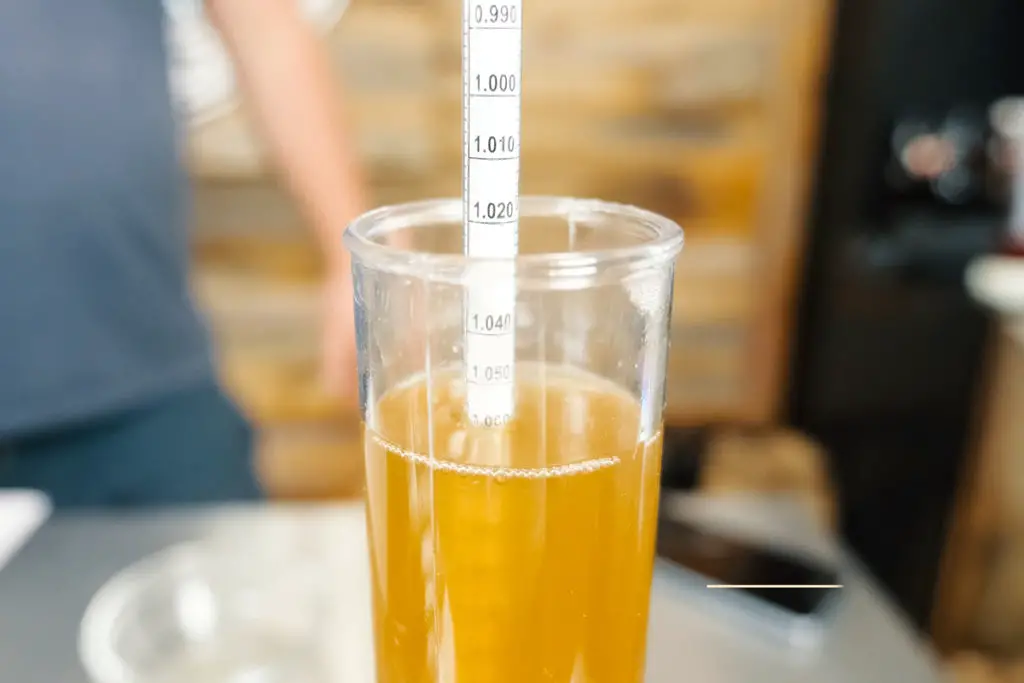Your new batch of homemade beer is ready for the taking. But before savoring the brew, you would like to know how much alcohol is in it. But you don’t have the original gravity to measure against. What can you do?
Here’s how you can measure alcohol content without the original gravity:
- Use the final gravity reading and attenuation rate of your beer wort.
- Use the freezing point to estimate the original gravity of your beer.
- Determine final gravity and final Brix value.
- Approach a laboratory with your beer.
Knowing the alcohol content may not be necessary, but it’s valuable knowledge for dedicated alcohol makers, especially when starting. An estimate may just be better than nothing at all.
1. Use the Final Gravity and Attenuation Rate of Your Beer Wort
If you missed getting the initial specific gravity reading but did get the final gravity, you can use that value to estimate the attenuation rate.
Attenuation rate is the decrease in specific gravity from the start of fermentation to the end. This difference occurs due to the fermentation process, as the fermentable sugar is converted into alcohol and carbon dioxide.

BEER DROP: Boxes of beer from Award-winning microbreweries → Join The Club
Usually, attenuation would need the original gravity value to calculate, but you can estimate if you have enough stock knowledge or experience.
A master brewer gave this particular example: the beer you made had a final gravity of 1.012. You may have gotten this value using a hydrometer reading or refractometer.
The final gravity value you got may have an equivalent attenuation rate of 75% – 80%. This implies that your product’s density has decreased by 75% – 80% since the start of fermentation. Following that logic, the final gravity should be around 25% or ¼ of your original gravity.
We then do the math. To make it simpler, just take the decimal part (.012), multiply it by 4 to get .048. Then add back the one to get 1.048 as the original gravity value.
Equation for ABV
After that, you can use the formula to get the alcohol by volume (ABV) or input it into an online calculator. You can use this equation for determining ABV:
ABV = [1.05/0.79 ((OG-FG)/FG)] * 100
2. Use the Freezing Point To Estimate for The Beers Original Gravity
Using the freezing point to get an original gravity estimate was a suggestion raised in a forum. However, they did note that it may be more challenging and not DIY-friendly, but you can give it a hand if you have some freeze-distill knowledge!
Freeze-distilling is a liquor industry practice that takes advantage of the different freezing points of alcohol (ethanol) and water. Ethanol and other alcohol flavor components freeze at much lower temperatures than water.
However, since it’s hard to achieve temperatures lower than 32°F (0°C), the freezing point of water, ethanol, and flavor substances cannot simply be extracted.
Instead, the whole drink is frozen completely and then left to defrost. Ethanol and other components will defrost earlier than water so that you can separate the former from the water.
Now, let’s go back to the main point, which is how to get the alcohol content. The freezing point has more or less the same value as the melting point since these are two opposing phase changes, i.e., liquid to solid, then vice versa.
Thus, if you get the melting point of the alcohol, which you can do by observing the deforestation process, you can get the freezing point.
You can then plug in estimated original gravity values in a calculator until it gives the melting point you have noted. You can also refer to this table, which shows a set of freezing point values and equivalent original gravity values. This value can then be used to get the final alcohol content.
This method isn’t terribly accurate, but it can give you an approximate alcohol percentage to work with.
3. Determine Final Gravity and Final Brix Value
Another simple way to get the final ABV is by using an online calculator. This one by BrewHeads only needs the final gravity and the final Brix value as input to calculate the alcohol content.
You can get the final gravity using a refractometer. It’s a simple device you can order online and uses only a few drops of your finished beer for analysis.
Some refractometers are adjusted for temperature already. Others also like No products found. at Amazon include the Brix reading in the scale so you can get the specific gravity and the Brix value simultaneously.
How To Use a Refractometer
In using a refractometer, calibrate the device first by opening the flap, putting a few drops of distilled water or other pure water on the glass, and then closing the flap again. If the refractometer didn’t come with a light source, point it to one and look through the lens to see the scale.
If the line that divides the white and blue section does not align with the 0 mark, adjust using the calibration screw. Afterward, you can proceed with the sample.
Clean the glass first, and then put a few drops of your beer. Afterward, look through the lens again, then get the reading using the scale.
Equation for Brix
If the refractometer doesn’t include Brix in the scale, you can convert the specific gravity value into Brix value using this equation:
Brix = (SG-1)/0.004
4. Approach a Laboratory With Your Beer
We had this method last because this may be the most complicated (and expensive) way to find out your homebrew’s alcohol content.

The American Society of Brewing Chemists (ASBC) has a standard method for determining the alcohol content of beer or other alcoholic beverage. Other laboratories may be following this method (or not). But either way, they’ll have standard practices that will allow them to determine ABV accurately.
The ASBC method involves distillation to extract the alcohol from the sample. Do note that distillation may be illegal in some areas, so it’s not recommended to do this at home. Thus, it’s better to contact a laboratory.
After the alcohol has been isolated, it’ll be placed in a density meter. The machine analyzes the ABV content.
You can also see if they do additional tests to determine the residual sugar content after fermentation and final gravity value.
Final Thoughts
Calculating the alcohol content without an original value can be difficult. Often, you’ll get approximations instead of accurate values, but this may be helpful knowledge you can use to see if you have met your benchmarks.
